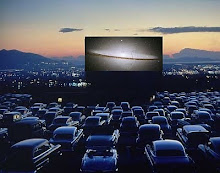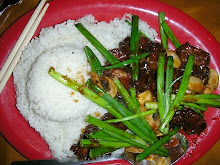We've pointed out elsewhere how it took Ana a while to appreciate the Mexicans' acceptance of death as a part of life, a view that on her planet might be considered inappropriate. Not everyone on Earth would agree, either. Yet the tiny figurines below clearly reveal that such an attitude is more affectionate than mocking. Thousands of these are made in Mexico. Many are for sale, and Ana loves them now. The examples below will give some indication.
First a professor, perhaps (note the owl, a symbol of wisdom on his desk):
Next, a nurse giving an injection to a patient (note the salt and bread on the table, to nourish the spirits):
A woman selling chickens:
A bride and groom:
A grand señora:
And let's not forget the family dog! (He has stolen a loaf of pan de muertos, the traditional bread made for this day.)
Monday, October 31, 2011
Saturday, October 29, 2011
Bhutanese architecture, similar to Thoman architecture, found by Ana in El Paso
As we know from Distant Cousin, Ana spent many years studying Earth from the moon. The quality of that study improved by several orders of magnitude following the advent of the internet, when it became possible for her to receive images, video clips, and movies from Earth. She was particularly astonished to discover the architecture of the tiny kingdom of Bhutan, half the size of Massachusetts, tucked away high in the Himalayas between India and China.
The larger Bhutanese buildings (see the photos above)--monasteries, temples, and official structures--were not that different from the buildings her ancestors erected long ago on the planet Thomo. After further study she was able to hypothesize why this should be, despite the unlikelihood of there having been any direct influence on her Earthly Proto-Indo European ancestors. Both Bhutanese and Thoman buildings are found in mountainous, lonely, hostile areas. In Bhutan, other people were the danger; on Thomo, the native wildlife was the threat. Both areas are seismically active. Thus in both cases, the walls of buildings were tall and immensely thick at the bottom and tapered toward the top. Arches and doorways were not curved, but squared off. And Ana instantly recognized the purpose of rooftop structures of Bhutanese buildings: they are watch towers, just as on Thomo.
So imagine Ana's surprise to discover, not long after she settled down in southern New Mexico, Bhutanese-style buildings not fifty miles from her, lots of them! The buildings of the University of Texas at El Paso have been built in that style for nearly a century! The reason is well known to people who live there. When the University was just beginning and the buildings being planned, the wife of a university (then a college) official noticed an article on Bhutan in National Geographic. The Bhutanese buildings perfectly suited the harsh, rocky mountains they were in, and the mountains in El Paso looked much the same. She suggested that style to the architects. The rest is history.
The photos below show some of the original buildings at UTEP and then a number of modern interpretations. The style has become famous. Some off-campus buildings now use the style, including a mall. The campus was even visited by a Bhutanese prince!
The larger Bhutanese buildings (see the photos above)--monasteries, temples, and official structures--were not that different from the buildings her ancestors erected long ago on the planet Thomo. After further study she was able to hypothesize why this should be, despite the unlikelihood of there having been any direct influence on her Earthly Proto-Indo European ancestors. Both Bhutanese and Thoman buildings are found in mountainous, lonely, hostile areas. In Bhutan, other people were the danger; on Thomo, the native wildlife was the threat. Both areas are seismically active. Thus in both cases, the walls of buildings were tall and immensely thick at the bottom and tapered toward the top. Arches and doorways were not curved, but squared off. And Ana instantly recognized the purpose of rooftop structures of Bhutanese buildings: they are watch towers, just as on Thomo.
So imagine Ana's surprise to discover, not long after she settled down in southern New Mexico, Bhutanese-style buildings not fifty miles from her, lots of them! The buildings of the University of Texas at El Paso have been built in that style for nearly a century! The reason is well known to people who live there. When the University was just beginning and the buildings being planned, the wife of a university (then a college) official noticed an article on Bhutan in National Geographic. The Bhutanese buildings perfectly suited the harsh, rocky mountains they were in, and the mountains in El Paso looked much the same. She suggested that style to the architects. The rest is history.
The photos below show some of the original buildings at UTEP and then a number of modern interpretations. The style has become famous. Some off-campus buildings now use the style, including a mall. The campus was even visited by a Bhutanese prince!
Labels:
Ana Darcy,
architecture,
Bhutan,
Thomo,
University of Texas at El Paso,
UTEP
Wednesday, October 26, 2011
New Mexican food!
After having just shown some photos of Mesilla's most famous restaurant, La Posta, it seems the perfect time to show some photos of New Mexican-style food! No one could be surprised that someone from another planet, like Ana, would love it. Everyone loves it.
Here's a shrimp salad with strips (rajas) of fresh green chiles from Hatch, New Mexico. These chiles are NOT picante. They are barely sauteed, fresh, crunchy, and delicately tangy, and probably cannot be duplicated anywhere outside of the region.
And finally, we have fresh chiles from Hatch, New Mexico, purchased at a farmer's market. The ones on the right are fresh, of course. The ones on the left have been roasted and peeled and then frozen, saving one the work of doing it at home. If you have a choice, this is the way to buy them. For the gardeners, we are told that the chiles most prized are Anaheim and Big Jim varieties.
Here's a shrimp salad with strips (rajas) of fresh green chiles from Hatch, New Mexico. These chiles are NOT picante. They are barely sauteed, fresh, crunchy, and delicately tangy, and probably cannot be duplicated anywhere outside of the region.
Here's a thin steak, Tampequeño style, laid on a red tomato sauce and white cheese, with sauteed tomatoes, onions, and chile rajas on top. Awesome!
Next, we have caldo de pollo (chicken soup). This was a small bowl!
In a bit of cross-cultural pollenization, here's a pizza with fresh chile rajas. ¡Sí, señor!
And finally, we have fresh chiles from Hatch, New Mexico, purchased at a farmer's market. The ones on the right are fresh, of course. The ones on the left have been roasted and peeled and then frozen, saving one the work of doing it at home. If you have a choice, this is the way to buy them. For the gardeners, we are told that the chiles most prized are Anaheim and Big Jim varieties.
See more food ideas in the column to the right under the photo of cranberry-apple pie a la mode-->
Labels:
caldo,
chile rajas,
gardeners,
Hatch chiles,
New Mexican food,
recipes,
tampiqueño
Tuesday, October 25, 2011
Ana's Favorite Restaurant: La Posta, in Mesilla, New Mexico
Even an extraterrestrial had no trouble realizing the unique qualities of La Posta restaurant in Mesilla, New Mexico. It's said that it is some 150 years old, when it began as a stagecoach stop.
Here are more photos. (RIght click into a new tab for details.)
Next post: let's sample the food!
Here are more photos. (RIght click into a new tab for details.)
When they were younger, the Méndez children loved the piranhas and the parrots (and the toucan, not pictured).
Next post: let's sample the food!
More pictures of Mesilla, the plaza, church, and agriculture:
Labels:
Ana Darcy,
extraterrestrial,
La Posta,
New Mexican food,
New Mexico,
parrots,
piranhas,
restaurant
Saturday, October 22, 2011
A look at some Mesilla Valley neighborhoods
Neighborhoods in the Mesilla Valley, however humble or upscale, tend to be homey, comfortable, and welcoming. Outsiders may not realize that it is against the law to build a home of any material which might burn--like wood. Wood has always been expensive in this area of few forests, and homes made of stone, adobe, brick, or concrete block tend to last...which means that when window frames or roofs become rickety, they are generally repaired rather than having the building demolished. (They also have the lowest fire insurance rates in the United States.)
Above and below are some random neighborhoods in Mesilla, near where the family of extraterrestrial distant cousin Ana Darcy lives, and several small villages to the south along Highway 28, all usually within several blocks of the Rio Grande river. Chope's is a locally popular eatery but the best known restaurant in the area is La Posta, in Mesilla. There are several photos elsewhere on this blog (see below), and we will soon have many more.
Perhaps you can tell: time has not exactly passed this area by, but it does move at a walking pace!
(Right click any photo to open in another tab for more detail.)
Friday, October 21, 2011
MORE of Ana's first sights on Earth: the Davis Mountains & Fort Bliss, Texas
Ana targeted her landing (in Distant Cousin) in the Davis Mountains close to the University of Texas McDonald Observatory. The picture below shows most of the Davis Mountains, looking south from an altitude of approximately 40,000 feet. (You may right click the photos and open in another tab for better detail.) The observatory domes are not visible in this photo, unfortunately, but they must be in the darker mountains along the far edge, where they give way to the lighter plains beyond. The town of Fort Davis may be the mottled area under the second red gizmo on the plane's wing. There would be a highway leading further into the distance, to Alpine, 30 miles south. It would have required very precise navigation to land in the proper canyon below the observatory--in the dark!
Without spoiling too much, here is some of what Ana could have seen when she was at Fort Bliss, Texas, in El Paso. First, the likely building she ended up in:
Then, the view from that approximate point showing the mountains she noticed (the Franklin Mountains, the southernmost end of the Rocky Mountains).
Next the boulevard with the stately houses (for flag officers, mostly):
Here's the alley she ended up in. The gate leading off base is at the end of it, on the left.
And here's that gate. The alley joins the street on the left, between the palm trees, by the stone column.
Without spoiling too much, here is some of what Ana could have seen when she was at Fort Bliss, Texas, in El Paso. First, the likely building she ended up in:
Then, the view from that approximate point showing the mountains she noticed (the Franklin Mountains, the southernmost end of the Rocky Mountains).
Next the boulevard with the stately houses (for flag officers, mostly):
Here's the alley she ended up in. The gate leading off base is at the end of it, on the left.
And here's that gate. The alley joins the street on the left, between the palm trees, by the stone column.
Monday, October 17, 2011
The humor in El Dia de los Muertos
We've mentioned elsewhere how Ana, from a different society and different planet, for Pete's sake, came to appreciate El Dia de los Muertos, the Mexican observance of All Souls' Day. After the terrible experiences her ancestors barely survived in their early days on Thomo, they inevitably came to value human life even more than we do, partly because they value it collectively as well as individually. That is, their survival as a people depended on working together. To be sure, they have their disagreements as all people do, but these almost never descend to war, or the taking of lives.
Yet also, like people on Earth, they grow old and die. Ana instantly saw the value of El Dia de los Muertos. Thomans too remember and revere their ancestors. But their attitude toward death is to treat it as an adversary, to be fought at all costs. The idea of accepting it as a part of living was new to her, and took some getting used to.
One thing that helped her understand this notion was the humor Mexicans bring to the celebration. They make, sell, and buy huge numbers of tiny effigies or sculptures whose message is impossible to miss. Above and below are some examples: a skeletal bride and groom, with the legend "Hasta que la muerte nos separa," or "Until death do us part," and an ancestral computer user whose screen reads "Hay amor," "There is love." (Click any of these to see more detail.)
Finally, another humorous little sculpture less associated with El Dia de los Muertos, a Colombian airliner. In the first photo, "Aero Susto" means "Air Fright." In the third, "Milagro! Volamos" means "A miracle! We're flying!" Note that the plane is laden with products of Colombia: bags of coffee, bananas, roses, and people praying, holding on for dear life, and clutching their hands to their breasts. Nor are the animals left behind!
More:
Meet Ana Darcy!
A reader comments: "Even though it was the fifth book the characters seemed fresh and alive. Al has always done a great job at character development and it continues in Recirculation. The book is about family values, but it doesn't stop there. There is plenty of adventure to keep you reading to the wee hours."
Subscribe to:
Posts (Atom)









































































